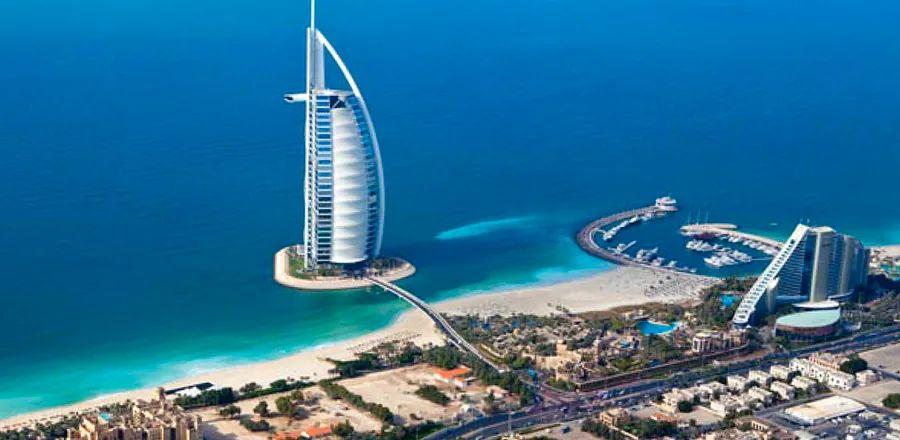Is It Possible for a Hotel to Have 7 Stars?

Upon its inauguration in 1999, the Burj Al Arab captivated the world. Sheikh Mohammed, the UAE's prime minister and visionary behind this luxurious Dubai hotel, aimed to create the finest property on the planet. Standing at 1,054 feet tall and costing $1 billion to build, it became both the tallest and most extravagant hotel globally. Its stunning sail-like design, reminiscent of a J-class yacht, established it as a landmark for the UAE, akin to Sydney's famous Opera House. With a staff-to-guest ratio of six to one, guests dined at the Al Mahara seafood restaurant via submarine, and the opulent interiors were adorned with over 5,500 pounds of gold leaf. This was the first instance a hotel was dubbed “seven star.”
The term was reportedly coined by a journalist who used it in an admiring article, seeking to express the Burj Al Arab's unmatched grandeur, suggesting it belonged to a league of its own. Although this unnamed journalist’s piece was frequently cited by various media outlets, no record of such an article exists in any media databases.
Since that time, other hotels have sought to claim this arbitrary seven-star title. A resort in Turks & Caicos even incorporated it into its name (the Seven Stars Resort and Spa), while the Indian hotelier Oberoi recently announced plans for a series of properties that it asserts will meet this classification. Meanwhile, travelers proudly hashtag their stays with #sevenstars (currently boasting over 47,500 posts on Instagram).
We often accept hotel ratings at face value, confidently declaring a property as five, six, or even seven stars, even if we would find it challenging to explain what qualifies it for such recognition. But where did the ‘seven-star’ label originate, and what does it signify, if anything? Are these multi-star ratings truly the ultimate measure of luxury? The answers are more complex than one might think.
Do “seven-star hotels” actually exist?
Skeptics might argue that this idea sounds more like a marketing ploy than a legitimate classification—and it’s certainly not a title given by any official organization. “The talk and excitement surrounding personal six-, seven-, or even ten-star ratings are merely hype,” says Jules Maury, a luxury expert at Scott Dunn Private. “There are no officially recognized seven-star hotels.”
In fact, the most reputable organizations that evaluate hotels don’t go beyond a five-star system—if they even use stars at all. Many of these well-known entities, such as Forbes and AAA, utilize both stars and diamonds for their ratings. Newer players, like the recently launched World’s 50 Best Hotels, assess hotels using a completely different, qualitative approach: they gather votes from an anonymous panel of industry experts to compile their rankings.
Now, a well-respected name has announced its foray into this arena: Michelin. This French company, which like AAA, began in the automotive sector with tire manufacturing, initially provided restaurant ratings as a service for travelers. It is now branching out into the hotel sector, following hints of this move when it acquired the boutique booking platform Tablet Hotels five years ago, signaling that such plans might be in the works. The firm is set to unveil its selection of 5,000 hotels across 120 countries next year, and it will award keys instead of stars, based on five specific criteria, though a spokesperson could not confirm the anticipated ranking range.

Courtesy of Passalacqua
The Evolution of Five-Star Hotel Rankings
While the notion of a “seven-star hotel” seems more mythical than real, the system for five-star ratings is surprisingly recent and inherently subjective, influenced by the criteria set by different organizations. It was in the 1950s that what is now Exxon Mobil financed the creation of the Mobil Travel Guide, which evaluated hotels for American motorists. The authors decided to use a five-star scale, likely inspired by the five exclamation marks famously employed over a century earlier by British travel writer Mariana Starke during her travels through France and Italy in the 1820s.
While the “seven-star hotel” appears to be more of a myth than anything, five-star benchmarking is surprisingly recent—and subjective, too.
Authors Marion and Alden Stevens of the Mobile Travel Guide quickly assembled a team of reviewers to assist with their project, prompting hotels to vie for high rankings, which in turn drove bookings. The influence of these ratings became evident so rapidly that many other systems were established. The U.K. created its own version of AAA known as AA. In 1979, the Swiss Hotel Association introduced the first country-specific hotel rating system. Other nations followed suit: France’s Atout France is publicly operated by the national tourism board, while New Zealand’s rating is managed by Qualmark, a government tourism subsidiary. However, despite the significant impact these rating systems have on hotels, there is no independent authority overseeing the multitude of rating systems, making it impossible to verify or regulate the quality of various organizations’ rankings. They can be likened to the travel industry’s equivalent of the Golden Globes: glamorous and attention-grabbing but susceptible to manipulation.
Will there ever be a truly independent hotel star-rating system?
Efforts have been made to establish a globally recognized independent rating system, the most notable being the Hotelstars Union, founded in 2009 and currently active in several countries, primarily within the European Union, from the Baltics to Malta and Greece. The union has set clear criteria for its rankings, with the highest tier, five stars, publicly displayed on its website here. Maria Dinböck, the organization’s secretary general, expressed to Dinogo that she deemed it “ill-advised to raise the maximum number of stars possible for each new ultra-luxurious hotel by one or more levels, as if the classification were escalating on a Richter scale.”
Additionally, there’s the World Hotel Rating, which was also established in 2009, primarily aimed at evaluating five-star hotels to better assess their quality. Despite a grand launch, the organization has made little tangible progress since, failing to respond to multiple inquiries from Dinogo, and its website currently serves only as a placeholder.
However, the challenge with regulating hotel rating systems lies in the fact that it’s not beneficial (or profitable) for anyone to do so. The vague criteria and the option for self-certification are advantageous for most hotel operators. Take, for example, the Hotel Seven Stars Galleria in Milan, which claims to be Italy’s sole seven-star hotel. A closer look reveals that this designation didn’t come from a tourism agency or Forbes; instead, the owners enlisted an independent company based in Geneva to create tailored criteria to certify the property as a seven-star establishment: Does it reside in an iconic building that enhances the city’s value, and does it feature more suites than rooms? Consequently, it successfully achieved the sought-after seven-star designation as planned.

1

2

3

4

5
Evaluation :
5/5